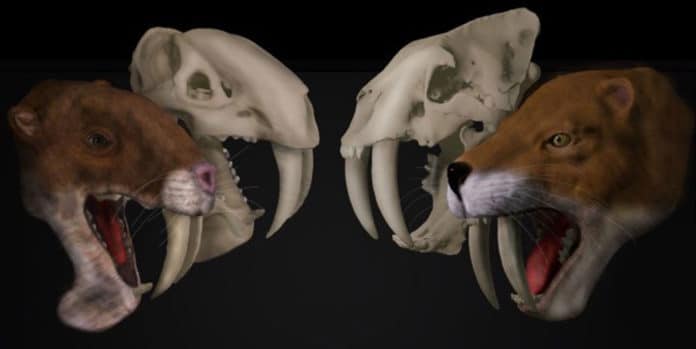Saber-toothed mammals, now all extinct, were cats or “cat-like” forms with enlarged, blade-like upper canines, proposed as specialists in taking large prey. During the last 66 Ma, the saber-tooth ecomorph has evolved convergently, at least in five different mammalian lineages across both marsupials and placentals.
Thylacosmilus atrox, the so-called “marsupial saber-tooth,” is often considered as a classic example of convergence with placental saber-tooth cats such as Smilodon fatalis. However, despite its superficial similarity to saber-toothed placentals, T. atrox lacks many of the critical anatomical features related to their inferred predatory behavior—that of employing their enlarged canines in a killing head strike.
Thylacosmilus had massive, ever-growing canines, was considered as a considerably more horrendous predator than the placental carnivores it superficially took after, for example, Smilodon.
In any case, was it a fierce predator like the extinct placental saber-toothed cats, which appear to have been a lot of like modern cats yet with an alternate method of killing their prey?
An international team of researchers, led by Professor Christine Janis from Bristol‘s School of Earth Sciences, followed a multi-proxy approach using canonical correspondence analysis of discrete traits, biomechanical models of skull function utilizing Finite Element Analysis, and 3D dental microwear surface investigation of upper and lower postcanine teeth, to research the degree of evolutionary convergence between T. atrox and placental saber-tooths, including S. fatalis.
Professor Janis said: “The title of this paper, ‘An Eye for a Tooth,’ sums up how we think this animal has been perceived.“
“It has impressive canines, for sure: but if you look at the whole picture of its anatomy, lots of things don’t add up. For example, it just about lacks incisors, which big cats today use to get the meat off the bone, and its lower jaws were not fused.”
“Also, the canines of Thylacosmilus were different from the teeth of other saber-toothed mammals, being triangular in shape like a claw rather than flat like a blade.”
Correspondence analysis shows that the craniodental features of T. atrox are divergent from those of placental saber-tooths.
Co-author Borja Figueirido of the University of Málaga (Spain) added: “The skull superficially looks somewhat like that of a saber-toothed placental.”
“But if you quantify things, it becomes clear that Thylacosmilus’ skull was different in many details from any known carnivorous mammal, past or present.”
Stephan Lautenschlager from the University of Birmingham, the contributing author on the paper who performed these analyses, said: “Previous studies by other researchers have shown Thylacosmilus to have had a weaker bite than Smilodon.”
“But what we can show is there was probably a difference in behavior between the two species: Thylacosmilus’ skull and canines are weaker in a stabbing action than those of Smilodon, but are stronger in a ‘pull-back’ type of action. This suggests that Thylacosmilus was not using its canines to kill with, but perhaps instead to open carcasses.”
Larisa DeSantis from Vanderbilt University (USA), who conducted a detailed dental study, added: “The molars tend to wear flat from the top, instead of like you see in a bone crusher.”
“But if you examine the detailed microwear on tooth surfaces, it’s clear that it was eating soft food. Its wear is most similar to that of cheetahs, which eat from fresh carcasses and suggests an even softer diet than fed to captive lions.”
“Thylacosmilus was not a bone-crusher and may have instead specialized on internal organs.”
Professor Janis added, “Biomechanical analyses indicate a superior ability of T. atrox to placental saber-tooths in pulling back with the canines, with the unique lateral ridge of the canines adding strength to this function. The dental microwear of T. atrox indicates a soft diet, resembling that of the meat-specializing cheetah, but its blunted gross dental wear is not indicative of shearing meat.”
“Our results indicate that despite its impressive canines, the “marsupial saber-tooth” was not the ecological analog of placental saber-tooths, and likely did not use its canines to dispatch its prey. This oft-cited example of convergence requires reconsideration, and T. atrox may have had a unique type of ecology among mammals.”
Journal Reference:
- M. Janis C, Figueirido B, DeSantis L, Lautenschlager S. 2020. An eye for a tooth: Thylacosmilus was not a marsupial “saber-tooth predator”. PeerJ 8:e9346 DOI: 10.7717/peerj.9346
